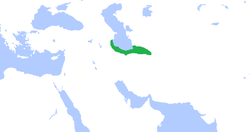
Back السلالة الدابوية Arabic گاوبارگان سیلسلهسی AZB Dabúyida Catalan Dabuyiderne Danish Dabuyiden German دودمان گاوباریان Persian Dabwaïhides French Dinasti Dabuyid ID Dabuyidi Italian گاوباریون MZN
This article may require copy editing for grammar, style, cohesion, tone, or spelling. (September 2023) |
Dabuyid dynasty | |||||||||||||||
|---|---|---|---|---|---|---|---|---|---|---|---|---|---|---|---|
| 642–760 | |||||||||||||||
 The Dabuyid dynasty around its greatest extent under Farrukhan the Great | |||||||||||||||
| Capital | Fuman (660–760)[1] | ||||||||||||||
| Common languages | Middle Persian, Caspian languages, Tabari | ||||||||||||||
| Religion | Zoroastrianism | ||||||||||||||
| Government | Monarchy | ||||||||||||||
| Ispahbadh | |||||||||||||||
• 640-660 | Gil Gavbara (first) | ||||||||||||||
• 740/41-759/60 | Khurshid (last) | ||||||||||||||
| Historical era | Middle Ages | ||||||||||||||
| 642 | |||||||||||||||
• Abbasid conquest | 760 | ||||||||||||||
| |||||||||||||||
| Today part of | Azerbaijan Iran Turkmenistan | ||||||||||||||
| History of Iran |
|---|
 The Gate of All Nations in Fars |
|
Timeline |
The Dabuyid dynasty, or Gaubarid dynasty, was a Zoroastrian[2] Iranian dynasty that started in the first half of the 7th century as an independent group of rulers that ruled over Tabaristan and parts of western Khorasan.[3] Dabuyid rule over Tabaristan and Khorasan lasted from around 642 to the Abbasid conquest in 760.
- ^ Bazin, Marcel (2000). "FŪMAN". Encyclopaedia Iranica, Vol. X, Fasc. 3. pp. 227–228.
- ^ C.E. Bosworth, The New Islamic Dynasties, (Columbia University Press, 1996), 162; "Hence in 758 the caliph undertook the definitive conquest of Tabaristan, successfully drove out Khurshid II and ended the dynasty of the Dabuyids (who, as Zoroastrians, had never accepted Islam)".
- ^ DABUYIDS, W. Madelung, Encyclopaedia Iranica